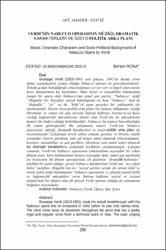Verdi’nin Nabucco Operasının müziği, dramatik karakterleri ve sosyo-politik arka planı
Citation
Rona, B . (2020). Verdi’nin Nabucco Operasının Müziği, Dramatik Karakterleri ve Sosyo-Politik Arka Planı . Afyon Kocatepe Üniversitesi Akademik Müzik Araştırmaları Dergisi , 6 (12) , 290-302 . Retrieved from https://dergipark.org.tr/tr/pub/amader/issue/55177/746348Abstract
Giuseppe Verdi (1813-1901) asıl çıkışını, 1842’de (henüz yirmi dokuz yaşındayken) yazmış olduğu Nabucco operası ile gerçekleştirmiştir. Teknik açıdan bakıldığında orkestralaması yer yer sert ve köşeli olan eserde koro, dinamizmini hiç kaybetmez. Düet, terzet ve ansambllar bakımından zengin bir opera olan Nabucco’nun temel şan partisi, “Nabucco” değil “Abigaille”dir. Karakter olarak bakıldığında ise hem “Nabucco” hem de “Abigaille”, “iyi” ya da “kötü”yü aşan gerçekçi bir yaklaşımla ele alınmışlardır. Eserin sosyo-politik arka planı söz konusu olduğunda, seçtiği librettolar ve onları ele alış tarzıyla İtalyan halkının Avusturya’ya karşı verdiği bağımsızlık mücadelesine destek olan Verdi’nin bu mücadelenin manevi bir önderi olduğu belirtilmelidir. Nabucco, bu manevi bayraktarlığın ilk somut göstergesidir. Bu çalışmanın amacı, Verdi’nin Nabucco operasının; müziği, dramatik karakterleri ve sosyo-politik arka planı ile incelenmesidir. Çalışmada tercih edilen yöntem, partitur ve libretto odaklı yorumdur. Eserin partituru yani şef notası temel alınarak orkestralaması, koroları, ansamblları ve şan partileri; librettosu yani metni temel alınarak ise dramatik karakterlerin psikolojik özellikleri çözümlenmiştir. Çalışma sonunda; Verdi’nin Nabucco operasının orkestralama açısından bir erken dönem eseri, koro kullanımının besteci açısından tipik, temel şan partisinin ise bestecinin ilk dönem operalarında sık gözlenen “dramatik-koloratur” nitelikte bir parti olduğu; ayrıca Nabucco karakterinin Verdi’nin “acı çeken baba” motifine, Abigaille’nin ise “sosyal şartları içinde ele alınan kötü”ye örnek teşkil ettiği bulunmuştur. Nabucco operasının, o yıllarda ulusal birlik ve bağımsızlık mücadelesi veren İtalyan halkının sosyal ve siyasal taleplerinin bir ifadesi olan ilk gerçek Verdi operası olduğu da çalışmanın bulguları arasındadır. Giuseppe Verdi (1813-1901) made his actual breakthrough with the Nabucco opera that he composed in 1842 (when he was only twenty-nine). The choir never loses its dynamism throughout the piece that has a partly rigid and angular score from a technical point of view. The main singing part of Nabucco, which is an opera rich in duets, terzets and ensembles, is not “Nabucco” but “Abigaille” Considering the characters, both “Nabucco” and “Abigaille” were handled by a realistic approach that transcends “good” or “bad.” When it comes to the socio-political background of the work, it should be noted that Verdi, who supported the Italian people's fight for independence against Austria with the librettos he chose and his way of handling them, was a spiritual leader of this fight. Nabucco is the first concrete sign of this spiritual leadership. The purpose of this study is to analyse the Nabucco Opera by Verdi with its music, dramatik characters and socio-political background. The method preferred in the study is score- and libretto-oriented reading. Scoring, choirs, ensembles and singing parts were analyzed based on the score of the work, namely the conductor's note; and the psychological features of the dramatic characters were analyzed based on its libretto, i.e. the text. At the end of the study; it was found that Nabucco opera by Verdi is an early work in terms of scoring, and the choral use is typical for the composer, and the main singing part is a "dramatic-coloratura" part, which is frequently observed in the composer's early operas, and “Nabucco” character is an example of Verdi's "suffering father" motif, while “Abigaille” sets an example of "evil handled in her own social conditions." The study also found that Nabucco is Verdi's first real opera that constituted an expression of the social and political demands of the Italian people who fought for national unity and independence in those years.
Source
Akademik Müzik Araştırmaları Dergisi “AMADER”Volume
6Issue
12URI
https://doi.org/10.36442/amader.2020.25https://dergipark.org.tr/tr/pub/amader/issue/55177/746348
https://hdl.handle.net/11630/8958
Collections
- Cilt 6 : Sayı 12 [6]



















